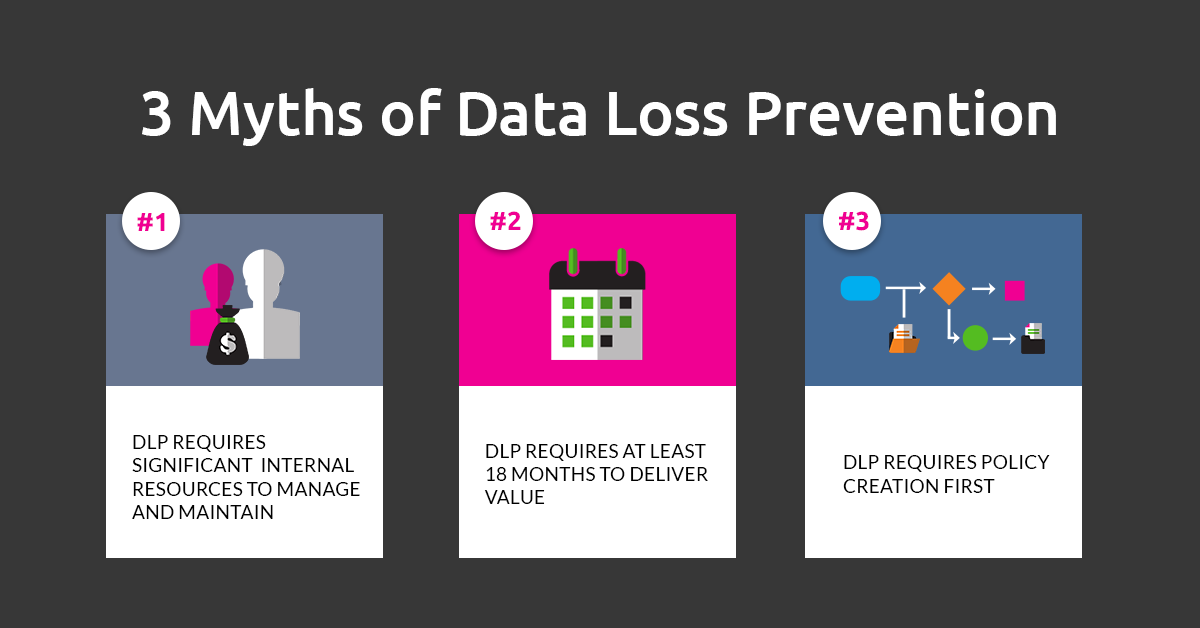DLP has been around for over a decade now and its history is filled with big interest and big expectations as well as some disillusionment. Today’s DLP solutions are sophisticated and savvy. They’re also at the fingertips of many more enterprises along with smaller businesses. Unfortunately, a few misconceptions still remain. So let’s clear the air.

Myth Number One: DLP requires significant internal resources to manage and maintain.
Though perhaps while a fledgling, DLP required more internal resources, newer options allow for much less exhausting maintenance. Over the years, automation and managed security services have been introduced to the market. That means less time and money spent by your team on nitpicking through hosting, setup, ongoing monitoring, tuning and maintenance and more time focusing on the important things, like strategizing and mitigating cybersecurity threats. If you decide to use a managed service provider, you don’t even need to worry about hiring a full infosecurity team. This solution fills the large gap between highly in-demand, qualified infosec professionals and the plethora of job openings. Managed service programs (MSPs) allow you to get complete data protection without additional hardware or staffing. They significantly lower the cost of DLP programs and give easy access to DLP for organizations of all sizes.
Myth Number Two: DLP requires at least 18 months to deliver value.
Say goodbye to delayed ROIs, and give a warm welcome to results you can see in just days. Now modular, DLP can be deployed in iterations as a continuously developing data protection program. You can start off with a base data protection solution that quickly delivers the value you need and then add on different modules over time to extend your protection on the network, add advanced encryption, and more! That way, you don’t have to implement a bulky DLP solution all at once, which would require more time and resources. Instead, you can just buy the modules that are relevant to your business and security needs and add more over time as newer solutions come on the market and your business needs evolve.
Myth Number Three: DLP requires policy creation first.
DLP is a lot smarter now. Instead of going through several rounds of trial and error with creating the appropriate policies, content- and context-aware DLP solutions collect information on what and how data is used and where it is going. Armed with this knowledge, business unit leaders can more intelligently define the right policies. With MSPs, DLP experts identify and classify critical data, discover risky user behavior that might compromise the data, and then create policies that protect the data.
Just like most technological solutions, DLP is ever-evolving. A computer used to be an excessively large, clunky machine and now we have smartphones, essentially handheld computers, with moderately intelligent AIs. Over the years, DLP has moved beyond the network into the endpoint, cloud, and discovery and has accelerated in both time to deployment and time to measurable value. The aforementioned myths are things of the past that today’s DLP solutions effectively address.
To learn more about DLP and how it can help protect your organization from evolving threats, read the eBook now.
Read more in our Definitive Guide to DLP Series
- Do you need DLP? Well, do you feel lucky?
- The Evolution of DLP: 4 Reasons Why DLP is Back in the Limelight
- Debunking the Three Myths of DLP
- Call it a Comeback: 7 Trends Driving the Resurgence of DLP
- All Trends Lead to Data-Centric Security
- What is Driving Your Data Protection Agenda? Determining the Right Approach to DLP
- Building a Value-Based Business Case for DLP
- Positioning DLP for Executive Buy-In
- 5 Criteria for Choosing the Right Managed Security Services Provider (MSSP)
- How to Evaluate DLP Solutions: 6 Steps to Follow and 10 Questions to Ask
- Getting Successful with DLP: Two Approaches for Quick DLP Wins
- Two Frameworks for DLP Success
Data protection is crucial for the health and survival or any organization but what does the future of the industry look like?
Get perspective from an expert in our new eBook
